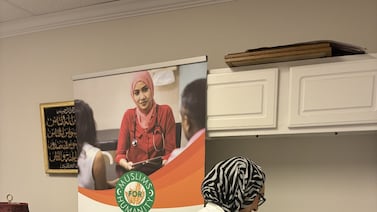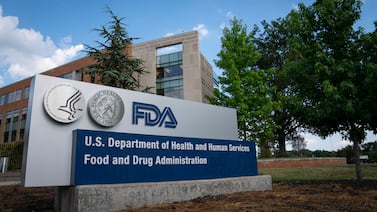This is a guest essay for Healthbeat. Public health, explained: Sign up to receive Healthbeat’s free national newsletter here.
Health organizations across the country face shrinking budgets. Federal agencies responsible for emergency preparedness are being restructured and consolidated. It’s hard enough just to keep track of the fusillade of changes, let alone respond to them. But paralysis is not an option for local leaders; the health of millions of Americans depends on how cities and counties prepare for and respond to the next health crisis.
The challenge is steep. Between 2017 and 2021, nearly half of all employees in local and state health departments left their positions. This workforce crisis predates the recent political turbulence — and leaves communities more vulnerable at a time when robust health infrastructure is needed most.
Yet within this challenge is an opportunity to plant a new vision — one that embraces an “always on” approach to emergency preparedness, by making readiness part of our everyday work. This vision rests on three essential pillars: hyperlocal community engagement; partnerships as an antidote to scarcity; and actionable data to drive strategy.
It’s about trust: Why hyperlocal approaches work
At its best, public health pairs breakthroughs with follow-through. The world eradicated smallpox not when the first immunization emerged in the 1790s, but two centuries later when it finally paired vaccines with highly coordinated monitoring and containment strategies. The Covid-19 pandemic reinforced that the most effective health interventions happen at the community level, delivered by trusted voices who understand local context and needs.
“Hyperlocal” approaches, going neighborhood by neighborhood, are effective because they recognize the heart of our struggle with communication: The real battle is not over facts, but over trust. Behind a nugget of information that takes hold is a web of individuals connected by mutual trust — and sometimes the promise of an alternative to the institutions or experts that have lost their confidence.
Community Health Workers, who come from the neighborhoods they serve, embody this idea. They are trusted not because of a title, not even just because they know a community — but because they are known to it. And they help deliver results. Last year, for example, Chicago rapidly contained a measles outbreak, administering 30,000 vaccinations in less than 3 months, by incorporating CHWs and partnering with local doctors.
In North Carolina, Operation Gateway mobilized CHWs after Hurricane Helene, providing immediate relief that complemented federal responses but did not await their starting whistle. And in Louisiana, community-based organizations opened church-based cooling centers and conducted neighborhood needs assessments during extreme heat events, demonstrating how community leaders provide essential infrastructure for emergency response.
Hyperlocal approaches are effective because they empower people with trusted relationships — but they face funding constraints and limits in addressing health challenges at scale. That’s where broader partnerships are needed.
Partnerships can help counter scarcity
We are already seeing diminished public budgets for health. As Your Local Epidemiologist uncovered, these cuts have human consequences, borne particularly tragically by low-income Americans, and erode preparedness for the next public health crisis.
Yet even as resources may become scarce, partnerships can help counter a scarcity mindset.
Partnerships add value because health threats don’t respect county lines or sectoral silos. Hospitals, health departments, clinicians, insurers, nonprofits, and community groups each hold a piece of the solution. And the more these pieces come together in quieter times, the less we have to scramble to assemble them when a crisis strikes.
For example, in Washington state, the Northwest Healthcare Response Network coordinates diverse players in emergency preparedness and response, ensuring hospital capacity is seen as a resource across jurisdictional lines. In Ohio, The Health Collaborative showed the benefit of regional, cross-sector partnership during the 2024 IV solution shortage. By pooling resources and coordinating distribution across multiple health systems, they prevented what could have become a crisis from compromising patient care.
Cross-sectoral coalitions unlock opportunities to address social factors like housing, food access, and social connection. New York City’s recent chronic disease plan provides a roadmap for engaging government agencies, health care systems, and nonprofits across a range of sectors — health, social services, and businesses — to tackle upstream drivers of chronic diseases. And the plan expands the city’s CHW footprint, known as the Public Health Corps, recognizing that the real work still happens block by block, neighbor to neighbor.
When resources are the barrier to forming partnerships, philanthropists can step up to fill specific funding gaps, and cities and counties should try innovative financing strategies, like public health bonds, to partially offset federal shortfalls. Funders will find that there are opportunities for dramatic return on investment when partnerships enable pooled resources, or open doors to interventions that address root causes rather than merely scratch the surface.
Of course, not every shortfall will be covered by philanthropy, and innovative financing won’t reach all communities. But where these tools are implemented, they can make the difference between fragile response and more durable readiness.
New models for sharing data can help find gaps early
Local leaders should assess what data streams they already have and establish agreements to share and analyze them now, before an emergency reveals the gaps. Many surveillance systems for detecting everything from novel pathogens to climate threats are now understaffed or offline due to budget cuts, leaving dangerous blind spots.
However, new models for data sharing are emerging. The Yale School of Public Health recently launched the popHIVE platform that integrates data from a wide range of sources, from national surveillance systems to clinical platforms like Epic Cosmos to Google Trends. Health leaders across the country can now access deeper insights from better-linked, near real-time data and maps. For example, popHIVE helps clinical leaders visualize how surges in RSV-related emergency room visits vary by age, helping optimize staffing and resource decisions.
In Minnesota, the Electronic Health Record Consortium shows how data sharing across the health system can create comprehensive pictures of community health. This type of integrated data sharing enables more targeted interventions, for instance to address an increase in opioid-related hospital visits in certain subpopulations.
An “always on” approach must strengthen both systems and relationships. That means conducting regular preparedness exercises, maintaining open communication channels, and establishing formal agreements well before they’re needed. These practices help with “turnover proofing” — systematizing ways of working that endure even when staff change roles.
Local health leaders can’t ‘wait on Washington’ to act
In every city and county across the nation, the health of Americans depends on how we navigate the uncertainty before us. During my time as New York City’s health commissioner, “we have to wait on Washington” was not an acceptable response to New Yorkers’ urgent needs; nor is it an acceptable answer to the patients in my exam room today.
Innovative partnership models can do more than bridge the gaps in federal leadership, they can help fix the fractures that have long been present and growing over time. The Japanese art of kintsugi can offer a valuable perspective. Practitioners of kintsugi don’t shy away from highlighting imperfections; they shine a light on the cracks and mend broken pottery with gold, making it even stronger than it was before. The bright spot in this moment of uncertainty is that we have an opportunity to strengthen systems that have shown their cracks.
Pioneering local leaders are already starting to set the fractures. Their work is both blueprint and warning: Without sustained support, even the best leaders will falter. With it, we have a chance to build systems that are responsive to local needs, always in ready posture, held together by partnership, and reinforced by trust.
Dr. Dave A. Chokshi is a physician at Bellevue Hospital, professor at the City College of New York, and chair of the Common Health Coalition. Previously, he served as health commissioner of New York City.







